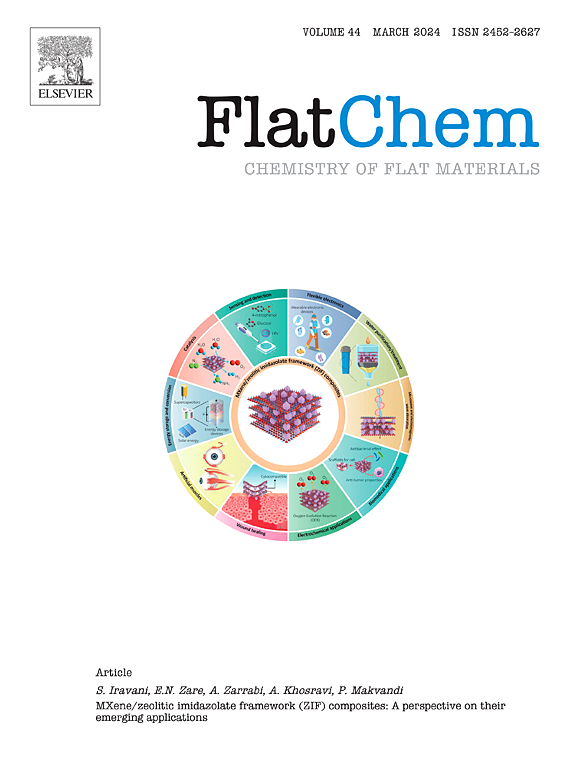利用微孔捕获和氮锚定协同作用构建单位点催化剂:一个理论见解
IF 5.9
3区 材料科学
Q2 CHEMISTRY, PHYSICAL
引用次数: 0
摘要
单位点催化剂以其最大的原子效率和独特的催化性能引起了人们的广泛关注。如何方便可控地制备ssc一直是一个具有挑战性的问题。最近,我们报道了利用微孔捕获和氮锚定协同作用构建的最简单的贵金属单位点催化剂。在此,我们采用密度泛函理论模型系统地揭示了不同尺寸微孔和金属络合阴离子的捕获策略背后的一般机制。结果表明,碳微孔可以很好地捕获具有相似大小和形状的金属络合阴离子,这是因为微孔的捕获效应来自于与参与原子数有关的范德华力和N掺杂剂的静电相互作用的协同作用。捕获的络合阴离子在微孔处逐渐还原,最终的配位与还原条件和络合阴离子的配体有关。通过调整碳微孔的大小和形状来匹配目标金属络合物阴离子,调节配体和还原条件来控制配位环境,为设计先进的ssc提供了新的途径。本文章由计算机程序翻译,如有差异,请以英文原文为准。

Construction of single-site catalysts by synergism of micropore trapping and nitrogen anchoring: A theoretical insight
Single-site catalysts (SSCs) have aroused broad interests due to their maximized atomic efficiency and unique catalytic properties. The facile and controllable preparation of SSCs is always a challenging issue. Very recently, we reported the simplest construction of precious-metal single-site catalysts by the synergism of micropore trapping and nitrogen anchoring. Herein, we employed density functional theory modelling to systematically reveal the general mechanism behind this trapping strategy with the different sizes of micropores and metal complex anions. The results demonstrate that the carbon micropores can well trap the metal complex anions with the similar size and shape, since the micropore trapping effect comes from the synergism of the van der Waals force relating to the number of involved atoms and the electrostatic interaction from N dopants. The captured complex anions gradually get reduced at the micropores, and the final coordination is related to the reduction condition and the ligands of the complex anions. The deep theoretical insight into this strategy provides a new route to design the advanced SSCs by tuning the size and shape of carbon micropores to match the targeted metal complex anions, and regulating the ligands and reduction conditions to control the coordination environment.
求助全文
通过发布文献求助,成功后即可免费获取论文全文。
去求助
来源期刊

FlatChem
Multiple-
CiteScore
8.40
自引率
6.50%
发文量
104
审稿时长
26 days
期刊介绍:
FlatChem - Chemistry of Flat Materials, a new voice in the community, publishes original and significant, cutting-edge research related to the chemistry of graphene and related 2D & layered materials. The overall aim of the journal is to combine the chemistry and applications of these materials, where the submission of communications, full papers, and concepts should contain chemistry in a materials context, which can be both experimental and/or theoretical. In addition to original research articles, FlatChem also offers reviews, minireviews, highlights and perspectives on the future of this research area with the scientific leaders in fields related to Flat Materials. Topics of interest include, but are not limited to, the following: -Design, synthesis, applications and investigation of graphene, graphene related materials and other 2D & layered materials (for example Silicene, Germanene, Phosphorene, MXenes, Boron nitride, Transition metal dichalcogenides) -Characterization of these materials using all forms of spectroscopy and microscopy techniques -Chemical modification or functionalization and dispersion of these materials, as well as interactions with other materials -Exploring the surface chemistry of these materials for applications in: Sensors or detectors in electrochemical/Lab on a Chip devices, Composite materials, Membranes, Environment technology, Catalysis for energy storage and conversion (for example fuel cells, supercapacitors, batteries, hydrogen storage), Biomedical technology (drug delivery, biosensing, bioimaging)
 求助内容:
求助内容: 应助结果提醒方式:
应助结果提醒方式:


